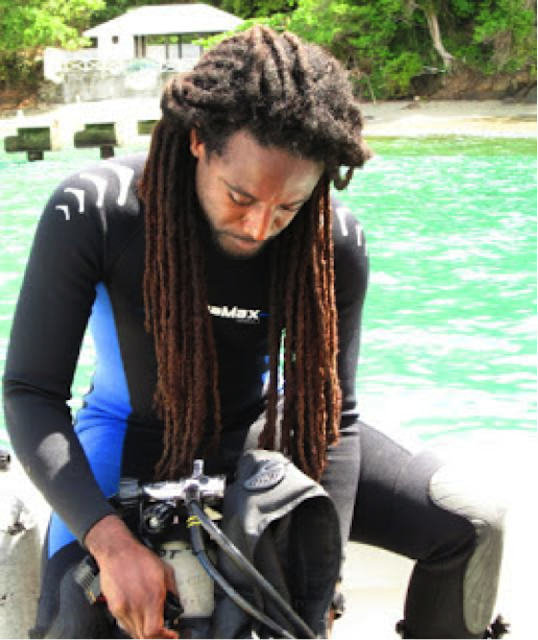Lights in the Lagoon
Jahson Alemu discusses the phenomenon known as bioluminescence, and conditions where it thrives: the protected Bon Accord Lagoon in Tobago is one of these rare spots.. Jahson is a marine biologist completing his PhD study on Buccoo Reef and its value in the ecosystem of south-west Tobago. This feature was first published in Tobago Newsday on Thursday, December 8, 2016. Follow Jahson on twitter: @jahson_alemu.
Imagine a world without light!
That may seem difficult to imagine and it is likely you don’t think about it often! But for several animals part of their lives are spent in absolute darkness (such as at night or in the deep sea), and as such, they have evolved to cope with life in darkness by producing their own light, much like fireflies. This ability is called bioluminescence and simply put, it is the production of light due to an internal chemical reaction. More technically, it is the light energy produced as a result of the interaction of the compound luciferin with oxygen catalysed by the enzyme luciferase. Regardless, bioluminescence allows organisms to produce their own light, which we see as glowing in the dark, and the darker it is, the more intense the glow. This ability is used quite often in the marine environment by several species to attract prey (e.g. anglerfish), scare away or confuse predators (e.g. plankton), to attract mates (e.g. lanternfish), and even to communicate (e.g. plankton and squid). Interestingly, dinoflagellates (tiny unicellular bioluminescent marine plankton), are the most commonly seen example of bioluminescence.
I’ll never forget the excitement I felt when I first saw bioluminescence as the ocean shimmered in fleeting sparkles of green around Gasparee Island. I would have the same feeling several years later while on a night dive in Tobago, where as I descended to 100ft, with every motion, ghostly threads of green and yellow trailed behind me. But it wouldn’t be until 2014 while on a bioluminescence tour with Radical Sports in the Bon Accord Lagoon that I would be awed by the cinema of living light.
 |
| The Bon Accord Lagoon, Tobago, is one of those rare places (called biobays) where conditions are right for bioluminescence. Photo courtesy Islands of Trinidad and Tobago |
There was no moon and it got darker as we paddled into the lagoon. But with every stroke our bows and paddles would glow. This was no gimmick, this was bioluminescence. Pretty soon we were seeing glowing fish darting about, and the bubbles they left also glowed which showed us where they came from. There was even a ray. Nothing moving in the water was hidden. The cause of this were bioluminescent dinoflagellate plankton (unicellular algae of the kingdom Protista). These microorganisms are autotrophic and produce their own energy through photosynthesis. What is most unique about them is that they use part of this energy to emit a bright flash of light whenever they are disturbed. The lagoon is rich with plankton, at concentrations high enough to produce this effect and as such is described as a biobay (bioluminescent bay).
 |
| Swim in light! Photo courtesy Radical Sports Tobago |
Biobays are rare ecosystems that occur when microscopic organisms called dinoflagellates thrive in numbers large enough (and under the right conditions) to produce a glow-in-the-dark effect when they are stirred to action such as, by a fish or paddle. And when they glow, so does anything that comes in contact with them. As our paddles entered the water, the agitation excited the plankton, and flashed blue-green from our bows and paddles with every stroke. Scientist believe that the flash is meant to simultaneously attract a predator and to surprise the cause of the disturbance, with the result being a decreased likelihood of the dinoflagellate being eaten.
The Bon Accord Lagoon is a protected inlet in Tobago’s protected marine park that holds millions of marine bioluminescent dinoflagellate plankton. The brackish water in this bay (a mix of salt water from the Caribbean and fresh water), combined with nutrients from decaying red mangrove trees (source of vitamin B12 required for dinoflagellate growth) make the area a perfect environment for bioluminescent dinoflagellates to thrive. Because the biobays require such exact conditions in order to form, there are very few in the world, and conservationists work tirelessly to preserve these unique phenomena. Arguably, Petit Trou in Tobago and parts of the Nariva Swamp support similar conditions to support biobays. The single most harmful species to these dinoflagellates are humans.
Current threats to these ecosystems include climate change and land based sources of pollution. Average ocean temperatures have steadily increased around Tobago over the last 15 years, and this rise would be even great for shallow ocean systems such as a lagoon. While plankton are adaptable, it is likely that a critical temperature threshold will be reached beyond which these plankton will not be able to survive. Additionally, waste (particulate or chemical) entering the lagoon can also affect the survival of these organisms; as the dinoflagellates are very sensitive to chemical pollutants such as heavy metals, industrial waste and sewage runoff (Lapota et al., 1993, 2007). Finally, an increase in light pollution in the area can reduce the observance of this phenomenon.
Ultimately, the maintenance of this unique ecosystem may lie in our ability to protect and conserve our mangrove forest, which support the bioluminescent dinoflagellates and aid in cleaning land-based wastewater that enters the lagoon.
 |
| Jahson Alemu Photo by Mark Pierre |
References:
Lapota, D., A.R. Osorio, C. Liao, and B. Bjorndal. "The use of bioluminescent dinoflagellates as an environmental risk-assessment tool." Marine Pollution Bulletin 54:12 (December 2007): 1857-67. Retrieved from http://www.ncbi.nlm.nih.gov/pubmed/17928009
Lapota, D., G.J. Moskowitz, D.E. Rosenberger, and J. Grovhoug. "The use of stimulable bioluminescence from marine dinoflagellates as a means of detecting toxicity in the marine environment." Naval Command Control and Ocean Surveillance Center (NCCOSC), Naval Facilities Engineering Command, 93-12127. 1993.



